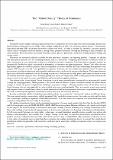| dc.contributor.author | Reed, Mark | |
| dc.contributor.author | Smith, Kord S. | |
| dc.contributor.author | Forget, Benoit Robert Yves | |
| dc.date.accessioned | 2022-01-21T23:03:47Z | |
| dc.date.available | 2021-10-27T20:29:17Z | |
| dc.date.available | 2022-01-21T23:03:47Z | |
| dc.date.issued | 2018 | |
| dc.identifier.issn | 1873-2100 | |
| dc.identifier.uri | https://hdl.handle.net/1721.1/135784.2 | |
| dc.description.abstract | © 2017 Elsevier Ltd Sustainable nuclear energy will likely require fast reactors to complement the current light water reactor paradigm. In particular, breed-and-burn sodium fast reactors (SFRs) offer a unique combination of fuel cycle and power density features. Unfortunately, large breed-and-burn SFRs are plagued by positive sodium void worth. In order to mitigate this drawback, one must quantify various sources of negative reactivity feedback, among which geometry distortions (bowing and flowering of fuel assemblies) are often dominant. These distortions arise mainly from three distinct physical phenomena: irradiation swelling, thermal swelling, and seismic events. Distortions are notoriously difficult to model, because they break symmetry and repeating patterns. Currently, no efficient and fully general method exists for computing neutronic effects of distortions. Computing them directly via diffusion would require construction of exotic meshes that seldom exist within the neutronics community. Many deterministic transport methods are geometrically flexible but tightly constrained by assumptions of symmetry and repeating patterns. Monte Carlo offers the only high-fidelity approach to arbitrary geometry, but resolving minute reactivities and flux shift tallies within large heterogeneous cores requires CPU years per case and is thus prohibitively expensive. Currently, the most widely-used methods consist of various approximations involving weighting the uniform radial swelling reactivity coefficient by the power distribution. These approximations agree fairly well with experimental data for flowering in some cores, but they are not fully general and cannot be trusted to work for arbitrary distortions in generic cores. Boundary perturbation theory, developed in the 1980s, is fully general and mathematically rigorous, but it is inaccurate for coarse mesh diffusion and has never been applied in industry. Our solution is the “virtual density” theory of neutronics, which alters material density (isotropically or anisotropically) instead of explicitly changing geometry. While geometry is discretized, material densities occupy a continuous domain; this allows density changes to obviate the greatest computational challenges of geometry changes. Although primitive forms of this theory exist in Soviet literature, they are only applicable to cases in which entire cores swell uniformly. Thus, we conceive a much more general and pragmatic form of virtual density theory to model non-uniform and localized geometry distortions via perturbation theory. In this work, we develop and implement virtual density theory entirely in the context of diffusion. In order to efficiently validate virtual density perturbation theory, we conceive the “virtual mesh” method for diffusion theory. This new method involves constructing a slightly perturbed “fake” mesh that produces correct first-order reactivity and flux shifts due to anisotropic swelling or expansion of individual mesh cells. First order reactivities computed on a virtual mesh agree with continuous energy Monte Carlo to within 1σ uncertainty. We validate virtual density theory via the virtual mesh method in 3-D coarse mesh models of the Fast Flux Test Facility (FFTF) and Jo¯yo¯ benchmarks using the MATLAB-PETSc-SLEPc (MaPS) multigroup finite difference diffusion code, which we developed for this purpose. We model a panoply of non-uniform anisotropic swelling scenarios, including axial swelling of individual assemblies, axial swelling of each mesh cell in proportion to its fission power, and radial core flowering with arbitrary axial dependence. In 3-D coarse mesh Cartesian cores with explicit coolant gaps, we model individual assembly motion, assembly row motion with arbitrary axial dependence, and assembly row “s-shape” bowing. In all cases, we find that virtual density perturbation theory predicts reactivity coefficients that agree with virtual mesh reference cases to within 0.01%. These reactivity coefficients are two to four orders of magnitude more accurate than those computed via boundary perturbation theory. In general, this virtual density perturbation method can precisely predict reactivity coefficients due to anisotropic swelling or expansion of any core region in any direction. | en_US |
| dc.language.iso | en | |
| dc.publisher | Elsevier BV | en_US |
| dc.relation.isversionof | https://dx.doi.org/10.1016/J.ANUCENE.2017.09.023 | en_US |
| dc.rights | Creative Commons Attribution-NonCommercial-NoDerivs License | en_US |
| dc.rights.uri | http://creativecommons.org/licenses/by-nc-nd/4.0/ | en_US |
| dc.source | Prof. Forget via Chris Sherratt | en_US |
| dc.title | The “virtual density” theory of neutronics | en_US |
| dc.type | Article | en_US |
| dc.contributor.department | Massachusetts Institute of Technology. Department of Nuclear Science and Engineering | en_US |
| dc.relation.journal | Annals of Nuclear Energy | en_US |
| dc.eprint.version | Author's final manuscript | en_US |
| dc.type.uri | http://purl.org/eprint/type/JournalArticle | en_US |
| eprint.status | http://purl.org/eprint/status/PeerReviewed | en_US |
| dc.date.updated | 2019-09-24T16:18:22Z | |
| dspace.orderedauthors | Reed, M; Smith, K; Forget, B | en_US |
| dspace.date.submission | 2019-09-24T16:18:24Z | |
| mit.journal.volume | 112 | en_US |
| mit.metadata.status | Publication Information Needed | en_US |
